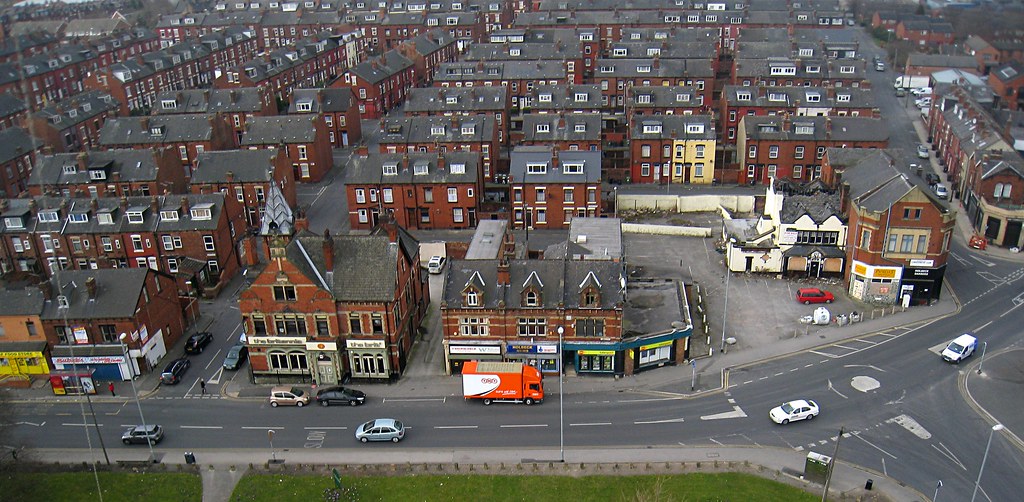In the late Georgian era, Britain’s urban population began to grow rapidly as the country’s economy shifted from agricultural to industrial. Many people left their country homes to pursue life in one of the newly developing industrial towns. To house these industrial workers near their workshops and manufactories, a new type of low-cost, high-density housing was developed—called the back-to-backs.
These houses in Birmingham are the city's last surviving court of back-to-back houses. Photo credit: Tony Hisgett/Flickr
Back to back houses were only one room deep and two or three storeys tall with a single entrance either from the street or from an inner yard. The ground floor performed the function of a living room, kitchen, dining room and bathroom, while the upper floors contained the bedrooms. As their name suggest, the houses shared the rear wall with another house facing in the opposite direction. One row of houses faced the street and the back row faced into a common inner courtyard. The courtyard contained the water tap, the washing line, the wash house, the toilets and the garbage bins. Narrow alleyways between the houses provided residents of the front row houses access to the courtyard, and residents of the back row houses access to the street. The houses facing the street were considered to be superior to those facing behind, and rent for the property reflected that.
Throughout the 18th and 19th centuries, back-to-backs were the most common form of urban housing for the working class in growing industrial towns. Factory owners in cities like Birmingham, Bradford, Leeds, Liverpool, Manchester, Salford, and Nottingham built them in hundreds of thousands to cram the maximum number of workers into the minimum space, at the lowest possible cost.
Image credit: www.thoresby.org.uk
Back-to-back houses were notoriously unhealthy. They were overcrowded, lacked light and ventilation, had poor drainage and bad sanitation. In 1875, the Public Health Act prohibited building of any more back-to-back houses. Despite this, they continued to be built in Leeds and Bradford until the 1909 Housing and Town Planning Act got rid of them altogether, declaring such accommodation unfit for human habitation. But Leeds still defied all opposition and continued to build them until the 1930s.
After the First World War, many towns demolished back-to-backs as part of post-war redevelopment program. This process continued until the 1970s. By then, most towns and cities had few or no back-to-back houses remaining, except Leeds and Bradford, which have a significant number of back-to-back houses that are occupied till this date.
In Birmingham, the last back-to-back courtyard at 50–54 Inge Street and 55–63 Hurst Street was saved from demolition and turned into a museum. They are the city’s last surviving court of back-to-back houses, and one of the few in the country which visitors can explore inside out.
Three boys play with guns along cobbled streets between rows of back-to-back terraced houses in Leeds, West Yorkshire, in July 1970. Many of these images, including the one above, were captured by photographer Nick Hedges who spent three years to documenting the lives of families living in slum and squalor throughout the UK in the 1960s and 1970s.
Back to back housing in Alleyway, Leeds, 1970. Photo credit: Nick Hedges
Child skipping in a street of back to back houses, Leeds 1970. Photo credit: Nick Hedges
Crossing wasteland from back to back housing towards railway line, Leeds 1970. Photo credit: Nick Hedges
Washing hanging out to dry across back to back housing street, Leeds 1970. Photo credit: Nick Hedges
Living room and kitchen Leeds back to back housing 1970. Photo credit: Nick Hedges
A woman and a child outside their back-to-back in Birmingham in the 1920s. Photo credit: Birmingham Mail
Photo credit: Birmingham Mail
Children playing outside back-to-back houses in Birmingham in 1956. Photo credit: Birmingham Mail
Brummies in a yard of back-to-backs in the 1920s in the Summer Lane neighbourhood, Birmingham. Photo credit: Birmingham Mail
Back-to-back houses in Summer Lane, Birmingham. Photo credit: Birmingham Mail
Back to back houses in Birmingham today. Photo credit: Tony Hisgett/Flickr
Back to back houses in Birmingham today. Photo credit: Tony Hisgett/Flickr
Back to back houses in Birmingham today. Photo credit: Nathan Reading/Flickr
Back-to-to houses in Beeston, a suburb of Leeds. Photo credit: Jon Peender/Flickr
Back-to-to houses in Beeston, a suburb of Leeds. Photo credit: Chris Jones/Flickr
Back to back houses, Holbeck Top Moorside, Leeds
Sources: Wikipedia / Wikipedia / Period House / www.bradfordhistorical.org.uk / www.booksie.com































Comments
Post a Comment